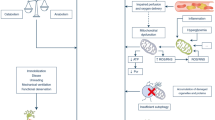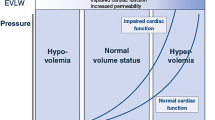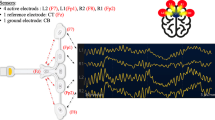Abstract
Objective
To measure muscle blood flow (Qtis) and oxygen consumption (VO2tis) in septic and non-septic critically ill patients by near-infrared spectroscopy (NIRS).
Setting
Surgical intensive care unit of a university hospital.
Patients and participants
Four patients with septic shock, eight post-surgical critically ill patients and ten healthy volunteers.
Measurements and results
Oxyhaemoglobin (HbO2) and deoxyhaemoglobin (HbH) variations after venous occlusion were measured by NIRS in the brachioradialis muscle. We calculated Qtis by the rate of HbO2 and HbH increase in the first 30 s of venous occlusion divided by haemoglobin blood concentration. VO2tis was calculated by subtraction of the arterial HbH from the initial increase of HbH after venous occlusion extrapolated to 1 min. Tissue oxygenation index [TOI = HbO2/(HbO2+HbH)] was also measured before venous occlusion. Two measurements in patients with septic shock, and one measurement in non-septic-shock patients and healthy subjects, were obtained. Of the measurements, 35% were repeated because of low-quality NIRS signal. VO2tis and Qtis were two times larger (P<0.05) in patients with septic shock than in patients without and in healthy subjects. The TOI was very similar among the three groups.
Conclusion
In septic-shock patients the increase in VO2tis was associated with an equivalent increase in Qtis. Therefore, tissue O2 supply does not seem to be a limiting factor for muscle O2 consumption. NIRS combined with venous occlusion allows a rapid, non-invasive and simultaneous assessment of regional perfusion and oxygen consumption. In case of microcirculatory shunt occurrence, the TOI should be cautiously used to assess tissue oxygenation state.

Similar content being viewed by others
References
Siegemund M, van Bommel J, Ince C (1999) Assessment of regional tissue oxygenation. Intensive Care Med 25:1044–1060
Boushel R, Piantadosi CA (2000) Near-infrared spectroscopy for monitoring muscle oxygenation. Acta Physiol Scand 168:615–622
Wahr JA, Tempeer KK, Samra S, Delpy DT (1996) Near infrared spectroscopy: theory and applications. J Cardiothorac Vasc Anesth 10:406–418
McKinley BA, Marvin RG, Cocanour CS, Moore FA (2000) Tissue hemoglobin O2 saturation during resuscitation of traumatic shock monitored using near infrared spectrometry. J Trauma 48:637–642
Varela JE, Cohn SM, Giannotti GD, Dolich MO, Ramon H, Wiseberg JA, McKenney M (2001) Near-infrared spectroscopy reflects changes in mesenteric and systemic perfusion during abdominal compartment syndrome. Surgery 129:363–370
De Blasi RA, Ferrari M, Antonelli M, Conti G, Amenrader N, Gasparetto A (1996) O2 consumption–O2 delivery relationship and arteriolar resistance in the forearm of critically ill patients measured by near infrared spectroscopy. Shock 6:319–325
Bone RC, Balk RA, Cerra FB (1992) American College of Chest Physicians/Society of Critical Care Medicine Consensus Conference. Definitions for sepsis and organ failure and guidelines for the use of innovative therapies in sepsis. Chest 101:1644–1655
Vincent JL, Moreno R, Takala J, Willatts S (1996) The SOFA (sepsis related organ failure assessment) score to describe organ dysfunction/failure. Intensive Care Med 22:707–710
Yoshitani K, Kawaguchi M, Tatsumi K, Kitaguchi K, Furuya H (2002) A comparison of the INVOS 4100 and the NIRO 300 near-infrared spectrophotometers. Anesth Analg 94:586–590
RA De Blasi, M Ferrari, A Natali, G Conti, A Mega, A Gasparetto (1994) Noninvasive measurement of forearm blood flow and oxygen consumption by near-infrared spectroscopy. J Appl Physiol 76:1388–1393
Fink MP (1998) Cytopathic hypoxia: mitochondrial dysfunction as a potential mechanism contributing to organ failure in sepsis. In: Sibbald WJ, Messmer K, Fink MP(eds) Tissue oxygenation in acute medicine. Springer, Berlin Heidelberg New York, pp 152–159
Ince C, Sinaasappel M (1999) Microcirculatory oxygenation and shunting in sepsis and shock. Crit Care Med 27:1369–1377
Boekstegers P, Weidenhofer S, Kapsner T, Werdan K (1994) Skeletal muscle partial pressure of oxygen in patients with sepsis. Crit Care Med 22:640–650
Sair M, Etherington PJ, Winlowe P, Evans TW (2001) Tissue oxygenation and perfusion in patients with systemic sepsis. Crit Care Med 29:1343–1349
Acknowledgments
We really thank Dott. C. Robino, Hamamatsu Italia and Dott. Tiziano Binzoni, Department de Physiologie, Centre Medicale Universitarie, Geneva, Switzerland.
Author information
Authors and Affiliations
Corresponding author
Rights and permissions
About this article
Cite this article
Girardis, M., Rinaldi, L., Busani, S. et al. Muscle perfusion and oxygen consumption by near-infrared spectroscopy in septic-shock and non-septic-shock patients. Intensive Care Med 29, 1173–1176 (2003). https://doi.org/10.1007/s00134-003-1805-0
Received:
Accepted:
Published:
Issue Date:
DOI: https://doi.org/10.1007/s00134-003-1805-0




